Abstract
In 2014, the European Union Directive 2014/24/EU was issued, which has provisions including information about the use of electronic technology for modelling buildings, referred to as BIM. According to various sources in the literature, with the help of BIM technology building designs can be prepared more quickly, while avoiding errors; it is also possible to generate and control any amendments in a building blueprint, promptly estimate costs of the building works planned, and implement a variety of activities connected with the maintenance of a new building once it is erected. In some EU states, initiatives have been launched leading to the introduction of BIM technology in public procurement, and the technology itself is now gaining popularity. However, the adaptation of this new technology is not always met with enthusiasm, and its implementation is hindered by many obstacles. The aim of this article is to conduct a broader analysis of the possibilities of BIM development in the construction industry based on data obtained from companies operating in the construction industry. The research used analysis of source materials, surveys, and targeted interviews. The study has demonstrated several barriers, of which the most important ones proved to be of financial nature, formal and legal considerations, and mentality, namely the unwillingness to learn, adopt novel solutions, and switch to a new way of working. The research was supported by a SWOT analysis.
1. Introduction
The development of IT solutions supporting the design in construction dates back to the 1950s and 1960s. At that time, it was possible to observe the development of software for making design drawings—from simple drafts to complete technical documentation—using computer-aided designing (CAD) programmes. These programmes enabled the generation of 2D drawings. In the 1970s, a third dimension was added, and in the 1980s a complete programme was developed with the function of modelling three-dimensional objects. Despite the evident progress in the development of software for engineers, making designs was still based on 2D drawings, while the 3D modelling of objects was used for the presentation of elements of buildings, their visualisation and attractive presentation of the work completed by architects and building engineers. The evolution of software programmes was directed towards the creation of foundations of a BIM technology. It was already then, that standardisation, which helped to organise work and record elements of drawings, began to emerge. The situation changed when 3D started to be used for making designs of buildings. First attempts were made to create parametric designs, where the parameters entered into the programme enabled the user to shape three-dimensional objects. When making a 3D-based design, the body of a building was shaped and the plans and cross-sections, which compose the technical documentation, were generated automatically [,,,,,].
The subsequent steps, taken currently, presume the assignment of various data to elements of a building. This enables one to take full advantage of BIM technology, and to create, for example, the timetable of building works of the breakdown of costs. Steps in the development of the mentioned technology are illustrated in Figure 1.
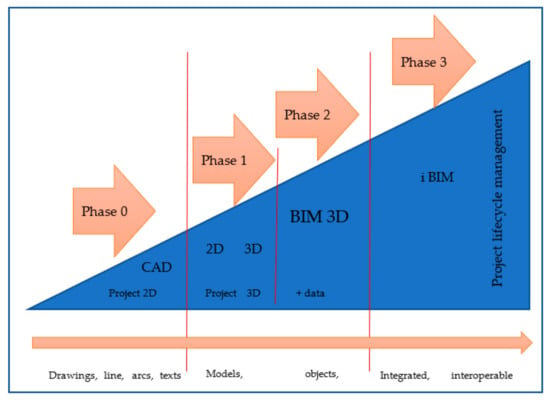
Figure 1.
BIM development (based on [,,,,,]).
The literature provides many definitions and descriptions of BIM technology [,]. The most common explanation is that this is the technology for modelling building objects that help to create a digital model of a building comprising the data for the visual presentation of a building, its physical and functional parameters, and parametric relationships between its elements. A model fed with as much data as possible can then be used at all stages of a building’s life cycle. The versatility of BIM technology is demonstrated in Figure 2.
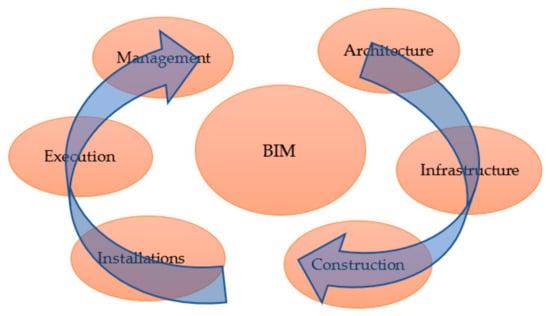
Figure 2.
Stages of building’s life cycle with BIM. Source: own elaboration.
Possibilities of Using BIM Technology in the Entire Life Cycle of a Building
The data contained in a model can serve to develop cost estimates and timetables of works, to make simulations and to design heating and air conditioning systems, and to plan any refurbishment or repairs of a building, including its demolition. It seems that the most numerous group of BIM technology prospective users pay special attention to the possibilities of making a building design based on 3D modelling, but the most important component of the acronym BIM is “the information” embedded in this model. A well-prepared and described model developed with BIM technology can facilitate many building works and can be used throughout the whole life cycle [,,,], including such stages as:
- Development of variants of design concepts;
- Creating 3D visualisations;
- Generation of components of design documentation;
- Creating cost estimates and work timetables;
- Simulating the process of constructing a building and its future use;
- Energy assessment of a building;
- Planning refurbishments or expansions of a building, including its demolition.
However, in order to fully employ the model, it is necessary to supply it with a full set of information. For example, complete information about the materials used allows one to make a cost estimate, develop documents related to the building’s demand for energy, and plan the demolition, including the information on which materials are suitable for recycling and which will have to be delivered to specialised, safe landfills.
The literature draws attention to the multi-dimensionality of BIM models [,,]. Moreover, 4D, 5D, and 6D models are mentioned. The fourth dimension is time, which is interpreted in a natural manner—as the time needed to make or assemble a subsequent element. Thus, a BIM model can be employed in the management of a building site, and the whole process can be visualised. The fifth dimension is the cost of a building, or principally the tools that allow the user to take advantage of the information contained in the model that refers to the materials from which particular elements of a building are made. A search engine of models coupled with specialised software is a tool used for the above purpose.
The sixth and seventh dimensions are the information concerning the management of a building once it is completed for use. Issues related to the instructions concerning the maintenance of a building and the planning of its repairs compose the sixth dimension, while sustainable development and the optimal consumption of energy belong to the seventh dimension. The diagram showing the multi-dimensionality of BIM technology is displayed in Figure 3.

Figure 3.
Diagram of multi-dimensionality of BIM technology (based on [,,,]).
An assumption underlying BIM technology is to create such a model of a building that will be useful at all steps of the development process and throughout the entire life cycle of the building [,,,]. The possibility of creating a 4D and a 5D model allows the user to plan the costs and time needed to complete the construction works, which in turn helps to manage the construction process. Additionally, 6D and 7D models, in turn, offer many options for use by building managers and occupants. The 8D BIM is a dimension that allows you to control safety at every stage of the life cycle of a construction facility. For example, at the construction stage, you can visualise the construction site taking into account the risks before the work begins. At the use stage, it can help ensure fire safety by visualising escape routes. The 9D dimension is a BIM dimension that allows for optimisation and improvement of all stages, thanks to the possibility of using virtual reality leading to constant monitoring of raw materials, processes, and optimal use of all resources.
Based on the data comprised in these models, it is possible to control energy consumption and to plan repairs, extensions, or even demolition of a building once its useful life is terminated. The use and management of the information written in a BIM model enhance the efficiency of many activities pursued during the development project and during the life cycle of the raised building. How BIM technology can be used in the consecutive stages of a building’s life cycle and during the development process is shown schematically in Figure 4.
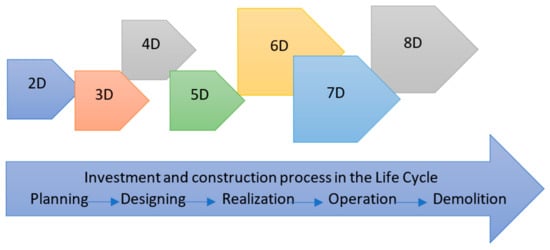
Figure 4.
Technology BIM in building investment process. Source: own elaboration.
2. Implementability of BIM Technology
As suggested above, the use of BIM technology can generate a number of benefits. This technology represents a universal approach to building design. In its principle, a BIM model of a building can be employed by various participants of a building process for a number of purposes. By entering numerous data, which are assigned to elements of a model, it is possible to create 4D–7D models. The consecutive dimensions of a BIM model correspond to the life cycle stages of a building. Nevertheless, the essential property that distinguishes BIM models from traditional ones is that all work is completed on a three-dimensional model rather than on two-dimensional drawings (Figure 5).
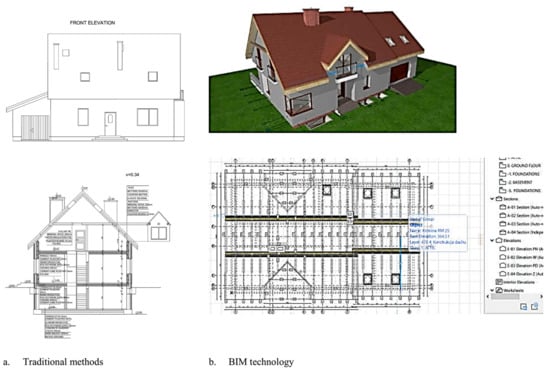
Figure 5.
Fragments of documentation prepared with traditional methods and BIM technology. Source: own elaboration.
In CAD technology, single drawings are independent from one another, and there are no automatic links between individual images, hence any changes must be added individually (Figure 5a). While creating the design of a building, the user of the CAD programme assigns the predefined properties of elements as symbols, using labels or descriptions, which are information carriers. Drawings provide an overview of the design, but rather than reflecting the reality they are most often presented via symbols. On the other hand, Figure 5b shows a fragment of BIM-generated documents, which are produced automatically, based on the created model. The user takes advantage of the materials that are actually available, which enables one to create a real model. BIM is based on parameters, and they are the carriers of the information about the properties of a given object. The model can be modified from any view, and changes will appear automatically in all other windows.
The model of a building, which is the basis for further development of a design, is made with the aid of a computer programme, which allows the user to assign to any element of a building all the data necessary in the subsequent stages of the building’s life cycle (Figure 6, Figure 7 and Figure 8). During the development process, various data appear, which are then entered into the shared “information exchange space” in the form of three basic groups: graphic data, non-graphic data, and documentation. Graphic models are a virtual reflection of the building, which is planned to be erected, including interiors, fixtures, equipment, analysis of natural light access, etc. (Figure 6). Non-graphic data are the core of the whole model, and they are a set of information, such as any material used, its physical properties, supplier, cost, durability, etc. (Figure 7). Classical documentation is the least used in BIM technology in the sense that there is increasingly more information that can be ascribed to the model and generated in software (Figure 8).

Figure 6.
BIM graphic model—insolation analysis. Source: own elaboration.
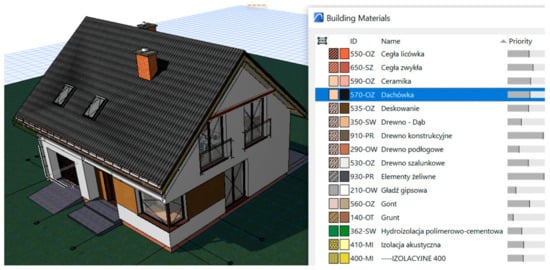
Figure 7.
Non-graphic data in BIM technology—building material. Source: own elaboration.
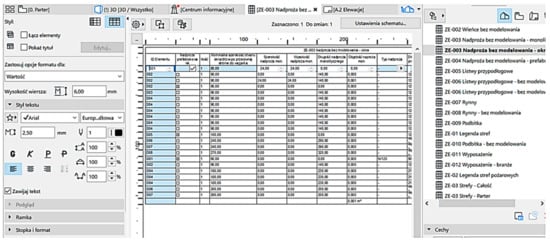
Figure 8.
Automatic generation of documentation in BIM technology. Source: own elaboration.
The illustrations in Figure 5, Figure 6, Figure 7 and Figure 8 reveal basic differences in the designs drawn on the basis of 2D drawings versus the ones created with BIM technology, based on 3D modelling. Apart from what we can see in the graphic layer of a design created with BIM software (ARCHICAD 25), other advantages are the ease of the management of documents, the possibility of sharing data with a multi-disciplinary team of professionals, and the ongoing monitoring of changes in the design and pinpointing possible collisions. Obviously, as mentioned before, the most significant element of a BIM model is the fact it incorporates data, which are useful at the subsequent stages of constructing a building and then during its whole life cycle.
An analysis of the subject literature reveals that researchers from different countries (e.g., Switzerland, China, and Australia) acknowledge the possibilities of using BIM technology at various stages in the building’s life cycle, and in different activities involved in the process of management of a construction development. The first articles that were published in the early 2000s concerned making designs, modelling, and management of a multi-disciplinary team [,]. In the subsequent years, there were articles dealing with the management of time, costs, and risk of building developments with the help of BIM technology [,,,].
There have also been several research papers since then discussing the use of BIM technology in planning and designing activities connected to sustainable construction and energy-saving measures [,,] as well as handling construction waste and recycling [,,,,,,,]. The authors of these publications come from different parts of the world, and most of them emphasise the universality of solutions and the usefulness of BIM models at different stages of the life cycle of building objects.
Despite the considerable advantages offered by BIM technology, the implementation of this technology in the construction business can be seen to clash with a number of obstacles. The relevant literature contains articles whose authors point to barriers to the implementation of BIM in various countries in Europe, Asia, and elsewhere in the world [,,,,,,,,,,,,,].
In Europe [], studied as a coherent area, most areas found a lack of trust in new things and resistance to introducing changes (lack of awareness, cultural change required, resistance to change cultural/staff, lack of demands, doubt about the vision of benefits). However, it varies in individual European countries. For example, in the United Kingdom [] problems resulting from the lack of involvement of management staff in activities for the development of BIM technology (lack of top management commitment) were identified. In Italy, as in Poland [,], the most important problems resulting from the transfer of knowledge about BIM technology and the related lack of information about the benefits of its introduction were indicated (low level of knowledge, low level of awareness of the benefits of using BIM), and financial matters (low prices of construction documentation, high software costs, high training costs, and no financial support).
The analysis included areas such as Asia, Africa, and the Arab regions. For example, in Pakistan [], the most important barriers are costs (the learning curve and training are costly, and BIM has a high initial cost of investment). Saudi Arabia [,,] is another country whose problems related to the introduction of BIM technology have been widely described in scientific articles. The research indicated that the biggest problems result from the lack of information about the benefits of introducing new technology (lack of recognition of the value of the innovation) and the problem with technical infrastructure (lack of technical competence, lack of technical capabilities). In contrast, in Malaysia [,,], studies have shown that, similarly to Pakistan, the biggest problem is the cost of introducing new technologies.
A review of the works of authors from various regions of the world indicates that the barriers observed during the research in the development of BIM technology in construction are repeated in many countries.
The area of Poland does not differ from other geographical regions in this respect; therefore, in further research, the authors relied on analyses conducted in the construction industry in Poland [].
The purpose of this article is to make a broader analysis of the possibilities of BIM development in the construction industry based on data obtained from companies operating in the construction sector. A comprehensive analysis taking into account both opportunities and threats for the effective implementation of BIM technology in the construction market [,,] combined with an assessment of the strengths and weaknesses of the technology allows us to precisely determine the possibilities of developing BIM technology at the present time.
An analysis taking into account both opportunities and threats for the effective implementation of BIM technology in the construction market combined with an assessment of the strengths and weaknesses of the technology will allow us to precisely determine the possibilities of developing BIM technology at the present time.
3. Materials and Methods
This study, whose goal was to make an assessment of possible implementation of BIM technology was completed stepwise. The first step consisted of an analysis of articles that show how this technology develops in other countries and what problems its development comes across. The second step was to conduct a survey study addressed to companies in the construction sector operating in the Polish market. The survey was carried out in 2021 and involved 46 construction companies, of which 48% were represented by construction designers, 19%—contractors and supervisors, 15%—investors, developers, and managers of buildings, and the remaining 18% included higher education staff, software developers, architects, and land surveyors. The information collected through the surveys underwent analysis, which enabled us to make a list of principal advantages and disadvantages of BIM technology, and then, based on the respondents’ replies, to determine which problems (threats) hinder the development of BIM technology, and to identify what activities could create better opportunities for a more rapid spread of this technology. The data obtained at this stage of the study were entered into a SWOT analysis in the next stage of this study, which allowed us to determine the situation on the market in terms of possible use of BIM on a broader scale in the near future. Figure 9 shows a diagram illustrating the research methodology.
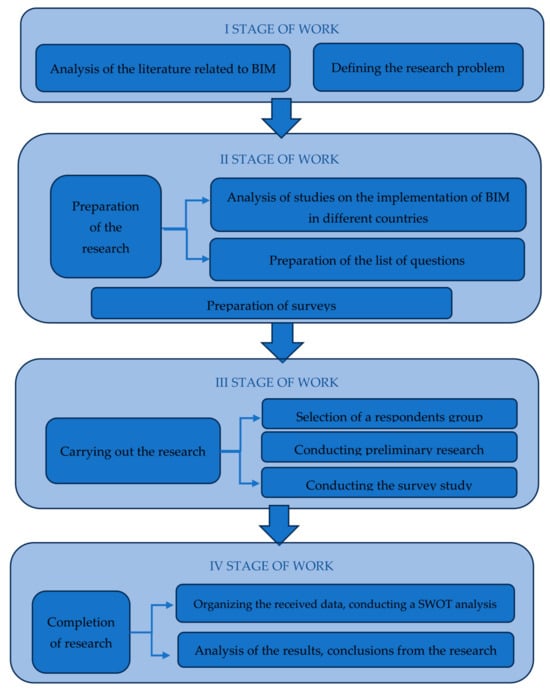
Figure 9.
Methodology and scope of research. Source: own elaboration.
According to our respondents, the most significant advantage of BIM technology is the improved communication between the parties involved in a building development project (including multi-disciplinary designer teams) and, consequently, better work efficiency (over 60% of respondents). Other pros indicated in the survey were better quality of building services (mainly avoidance of collisions) and control over the course of a building process (over 40% of respondents). More than 30% of respondents acknowledged the possibility of using all collected data in the entire life cycle of a building. A much smaller proportion of respondents point to such benefits of using BIM as more timely completion of building works, the fact that BIM is useful at the stage of management of a new building, and improved competitiveness in the market. A total of 10% of respondents concluded that the implementation of BIM did not bring about any significant benefits.
Details of the research conducted and the results obtained during the surveys are presented in Figure 10 and Figure 11. Figure 10 show the survey layout, and Figure 11 and Figure 12 show the research results presented as a percentage of the responses obtained.
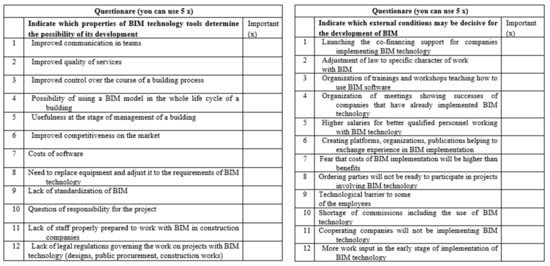
Figure 10.
The structure of questionnaires used in research. Source: own elaboration.
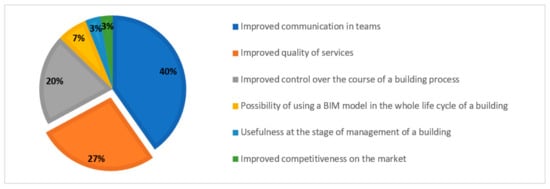
Figure 11.
The research results. Source: own elaboration.
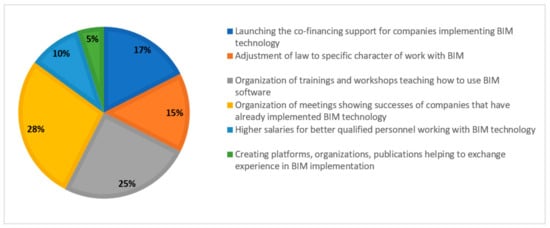
Figure 12.
The research results. Source: own elaboration.
3.1. Advantages and Disadvantages of BIM Technology Having an Impact on Its Popularity
Our analysis of the responses obtained through the survey allowed us to pinpoint the most important advantages of using BIM in building practice. Furthermore, the same group of respondents were requested to indicate the biggest disadvantages and problems related to the use of BIM in construction. The gravest problem was the cost of the software needed to employ BIM in construction companies (over 60% of indications), and the need to adjust the company’s equipment and infrastructure to what the new technology required (over 35% of respondents), followed by the lack of BIM standardisation in Poland (nearly 30%). Other drawbacks indicated by single respondents included the problem of responsibility for a design made with the aid of BIM. Our analysis of the responses allowed us to distinguish the basic disadvantages of the mentioned technology (Table 1).

Table 1.
Advantages and disadvantages of BIM technology. Source: own elaboration.
In connection with the observed advantages and disadvantages of BIM technology, there are constantly new initiatives appearing that support and promote the new approach. Training and workshops for representatives of the construction sector offered by producers of BIM software are very helpful in this respect. When scrutinising the market, it is also possible to notice some opportunities for further development of BIM as well as a number of threats.
3.2. Opportunities and Threats for the Development of BIM Technology
Within this study, representatives of the construction industry were also asked to indicate the gravest threats to the development of BIM technology in Poland. The first group of threats arises from the business activity of the companies. The most significant threat was the fear that the costs of BIM implementation might surpass potential benefits (46%). Another risk noticed by the respondents was the technological barrier for some employees. Cooperating companies will not be using this technology, and the shortage of commissions with the use of BIM technology on the construction market are some other risks mentioned by around 30% of respondents. Other threats associated with the implementation of this new technology include more labour input (at least at the launch of the technology—23%), and the need to employ new, qualified staff (18%). We also analysed the threats on a global (national) scale. The respondents expressed concerns that public procurement officials might not be properly prepared to participate in projects using BIM (over 50% indications), while 33% of respondents were worried that the requirements concerning the use of BIM technology would be excessively high relative to the market’s possibilities. Other worries relate to financial matters (ca 30% of respondents): costs of the implementation of BIM can lead to the bankruptcy of smaller companies, and the introduction of expensive technologies can result in the rise of prices quoted in the construction sector (whereas the costs of preparing documentation for a building development project are still too low).
The survey participants were also asked what chances for the future spread of BIM technology they could see. Over 60% indicated the need to provide additional funds towards the transformation of the market and introduction of BIM technology, in terms of both software development and modernisation of the infrastructure of companies. Another important step supporting the development of this technology is the adjustment of law to the specific characteristics of BIM project execution (including professional responsibilities, standardisation, and public procurement procedures—35% indications). Yet another very important measure indicated is to improve the level of knowledge and awareness regarding BIM in the construction sector (30%) by holding trainings and workshops for all branches of the industry, and a plan of co-financing participation in such educational events. It is also important to take measures in order to shape the attitude to changes and novelties. Such work on mental change in the building sector should include organising meetings and seminars at which companies that have already started using BIM technology could present the benefits they have achieved. Below, in Table 2, we collated the opportunities and threats to the development of BIM technology in Poland in light of the survey results.

Table 2.
Opportunities and threats for BIM technology development. Source: own elaboration.
4. Research Course and Results
In order to assess the implementability of BIM technology in Poland, a SWOT analysis was made. The information collected through the survey enabled us to draw up a list of the most important strengths and weaknesses, as well as opportunities and threats related to the spread of this technology. The subsequent step was to determine their weights for the previously defined factors (Table 3). The weights were determined according to the percentage analysis of respondents’ replies. The more respondents gave a reply, the higher weight was assigned to it. A standardisation calculation was used to determine the final values.

Table 3.
List of weights for the factors considered in the research. Source: own elaboration.
The following step consisted of an analysis leading to an answer to the question of whether the identified strengths would allow using the opportunities (Table 4) and mitigating the threats (Table 5).

Table 4.
Analysis of the impact of strengths on the possibility of taking advantage of opportunities. Source: own elaboration.

Table 5.
Analysis of the possibilities of mitigating threats by strengths. Source: own elaboration.
The subsequent steps in the SWOT analysis comprise the study aiming to answer the question of whether the weaknesses would prohibit taking advantage of opportunities (Table 6) or would fortify the impact of threats (Table 7).

Table 6.
Assessment of whether weaknesses will prohibit taking advantage of opportunities. Source: own elaboration.

Table 7.
Assessment of whether weaknesses will fortify threats. Source: own elaboration.
The SWOT analysis showed that there is much to be completed yet in the sphere of BIM implementation in the construction sector in Poland. Weaknesses, stemming from the disadvantages indicated in the survey questionnaires, are still prevalent, and to make things worse these disadvantages strengthen the threats to the implementability of this technology (Table 8).

Table 8.
SWOT analysis matrix. Source: own elaboration.
5. Discussion of the Results of the Analysis
The analysis revealed that the factors producing the strongest impact on the possibilities of using the opportunities and mitigating the threats are strengths S3 and S6. These are the improvement of competitiveness in the market and the possibility of monitoring the whole process. This result testifies to the respondents being aware that the application of BIM technology can improve the position of companies in the building sector. The weaknesses that will prohibit the use of emerging opportunities are, according to respondents, W3—lack of BIM standardisation, and W4—the problem of responsibility of a project, which are both factors dependent on legal regulations, which lag behind technological change. The weaknesses that can fortify the threats to the highest degree are W2—the need to replace the equipment and adjust it to BIM, and W4—the problem of the responsibility for a project.
The strengths that will allow the user to take advantage of the opportunities the most are O1—launching the co-financing support dedicated to companies which are implementing BIM, and O3—organisation of training and workshops dealing with the use of BIM.
The threats whose impact can be fortified by the previously identified weaknesses are mainly T6—greater work input in the early stage of BIM implementation, and T3—a technological barrier to some of the staff.
Among the most important factors, in addition to the problems connected with legal regulations, most are associated with the mental attitude of employees and the costs due to the implementation of BIM in the building market.
Analysing the literature on the subject, it can be noticed that over time the situation related to the implementation of BIM technology in practice is changing. At the beginning of the 2000s, most respondents showed that the method of preparing documentation and the possibility of coordinating work in multi-disciplinary teams are the greatest benefits resulting from the use of BIM tools. Currently, most respondents believe in improving market competitiveness and the ability to control the entire process in the life cycle of a construction project. This may indicate the increasing awareness of construction process participants. Despite this, most respondents noted the lack of standardisation, problems with regulations not keeping up with changes, and problems with the division of responsibilities.
Increasing awareness is also evidenced by the fact that financial issues rank lower among barriers, whereas in the early 2000s it was a priority issue.
Many respondents point out the need to organise various types of training and workshops to raise the awareness of process participants, which will help overcome the reluctance to introduce changes.
6. Conclusions
BIM technology appeared in the construction sector several years ago. Throughout that time, many activities have been undertaken to facilitate its application in practice, for example, workshops, training, seminars, and conferences, where one of the aims was to provide as much information as possible about the options offered by the software and how it could be applied in the consecutive stages in a building’s life cycle. Despite the unquestionable advantages, the spread of this new technology encounters many difficulties in practice. Publications authored by researchers around the world point to various underlying reasons, referred to as barriers. The barriers most often mentioned in studies carried out in different countries can be classified as legal, financial, and mental ones, the latter related to the attitude to novelty. Studies carried out in Poland attest to the presence of similar barriers to the implementation of BIM technology. This study, based on a survey addressed to a previously distinguished group of respondents, additionally informed us what measures should be taken in order to alleviate or eliminate some barriers. The respondents proposed solutions to the diagnosed problems tailored to the nature of individual barriers. They indicate the need to provide financial support to the implementation of BIM in construction companies, to put more emphasis on broader and more effective training, and to take action for the sake of regulating the formal and legal framework pertaining to BIM-based modelling of buildings.
The topic of implementing technology in practice is still relevant, and research on the progress and development of this technology in the construction industry can provide a lot of information about the possibilities of developing BIM tools in the future.
Author Contributions
Conceptualisation, E.S. and M.J.; methodology, E.S.; software, M.J.; validation, E.S. and M.J.; formal analysis, E.S.; resources, E.S. and M.J.; writing—original draft preparation, E.S. and M.J.; writing—review and editing, E.S.; visualisation, M.J. All authors have read and agreed to the published version of the manuscript.
Funding
This research received no external funding.
Institutional Review Board Statement
Not applicable.
Informed Consent Statement
Not applicable.
Data Availability Statement
Data are contained within the article.
Acknowledgments
We would like to acknowledge every people from construction enterprises for taking part in the research.
Conflicts of Interest
The authors declare no conflicts of interest.
References
- Chen, H.; Hou, L.; Zhang, G.K.; Moon, S. Development of BIM, IoT and AR/VR technologies for fire safety and upskilling. Autom. Constr. 2021, 125, 103631. [Google Scholar] [CrossRef]
- Azhar, S. Building information modeling (BIM): Trends, benefits, risks, and challenges for the AEC industry. Leadersh. Manag. Eng. 2011, 11, 241–252. [Google Scholar] [CrossRef]
- Bynum, P.; Issa, R.R.; Olbina, S. Building information modeling in support of sustainable design and construction. J. Constr. Eng. Manag. 2013, 139, 24–34. [Google Scholar] [CrossRef]
- Chen, K.; Lu, W. Bridging BIM and building (BBB) for information management in construction. Eng. Constr. Archit. Manag. 2019, 26, 1518–1532. [Google Scholar] [CrossRef]
- Demian, P.; Walters, D. The advantages of information management through building information modelling. Constr. Manag. Econ. 2014, 32, 1153–1165. [Google Scholar] [CrossRef]
- Dixit, M.K.; Venkatraj, V.; Ostadalimakhmalbaf, M.; Pariafsai, F.; Lavy, S. Integration of facility management and building information modeling (BIM). Facilities 2019, 37, 455–483. [Google Scholar] [CrossRef]
- Davies, K.; Wilkinson, S.; McMeel, D. A Review of Specialist Role Definitions in BIM Guides and Standards. J. Inf. Technol. Constr. 2017, 22, 185–203. Available online: https://hdl.handle.net/2292/44379 (accessed on 1 October 2023).
- Wildenauer, A.A. Critical assessment of the existing definitions of BIM dimensions on the example of Switzerland. Int. J. Civ. Eng. Technol. 2020, 11, 134–151. [Google Scholar] [CrossRef]
- Lee, G.; Sacks, R.; Eastman, C.M. Specifying parametric building object behavior (BOB) for a building information modeling system. Autom. Constr. 2006, 15, 758–776. [Google Scholar] [CrossRef]
- Jin, R.; Zhong, B.; Ma Hashemi, A.; Ding, L. Integrating BIM with building performance analysis in project life-cycle. Autom. Constr. 2019, 106, 102861. [Google Scholar] [CrossRef]
- Wong, J.K.W.; Zhou, J. Enhancing environmental sustainability over building life cycles through green BIM: A review. Autom. Constr. 2015, 57, 156–165. [Google Scholar] [CrossRef]
- Ding, L.; Xu, X. Application of cloud storage on BIM life-cycle management. Int. J. Adv. Robot. Syst. 2014, 11, 129. [Google Scholar] [CrossRef]
- Meng, Q.; Zhang, Y.; Li, Z.; Shi, W.; Wang, J.; Sun, Y.; Xu Li Wang, X. A review of integrated applications of BIM and related technologies in whole building life cycle. Eng. Constr. Archit. Manag. 2020, 27, 1647–1677. [Google Scholar] [CrossRef]
- Cao, D.; Shao, S.; Huang, B.; Wang, G. Multidimensional behavioral responses to the implementation of BIM in construction projects: An empirical study in China. Eng. Constr. Archit. Manag. 2022, 29, 819–841. [Google Scholar] [CrossRef]
- Mihaylenko, V.; Honcharenko, T.; Chupryna, K.; Liazschenko, T. Integrated processing of spatial information based on multidimensional data models for general planning tasks. Int. J. Comput. 2021, 20, 55–62. [Google Scholar] [CrossRef]
- Ibrahim, M.; Krawczyk, R.; Schipporeit, G. The level of knowledge of CAD objects within the building information model. In Proceedings of the Association for Computer-Aided Design in Architecture 2003, Bangkok, Thailand, 24–27 October 2003; pp. 172–177. [Google Scholar]
- Ameziane, F. An Information Systems for Building Production Management. Int. J. Prod. Econ. 2000, 64, 345–358. [Google Scholar] [CrossRef]
- Caniëls, M.C.J.; Chiocchio, F.; van Loon, N.P. Collaboration in project teams: The role of mastery and performance climates. Int. J. Proj. Manag. 2019, 37, 1–13. [Google Scholar] [CrossRef]
- Matarneh, S.T.; Danso-Amoako, M.; Al-Bizri, S.; Gaterell, M.; Matarneh, R. Building information modeling for facilities management: A literature review and future research directions. J. Build. Eng. 2019, 24, 100755. [Google Scholar] [CrossRef]
- Olawumi, T.O.; Chan, D.W. Building information modelling and project information management framework for construction projects. J. Civ. Eng. Manag. 2019, 25, 53–75. [Google Scholar] [CrossRef]
- Seyis, S. Mixed method review for integrating building information modeling and life-cycle assessments. Build Environ. 2020, 173, 106703. [Google Scholar] [CrossRef]
- Szafranko, E. Applicability of multi-criteria analysis methods for the choice of material and technology solutions in building structures. Teh. Vjesn. 2017, 24, 1935–1940. [Google Scholar] [CrossRef]
- Lesniewski, L.; Berkebile, B. Sustainable Design and Construction, Integrated Delivery Processes, and Building Information Modeling. In Sustainable Built Environments; Springer: New York, NY, USA, 2020; pp. 551–572. [Google Scholar] [CrossRef]
- Liu, Z.; Jiang, L.; Osmani, M.; Demian, P. Building information management (BIM) and blockchain (BC) for sustainable building design information management framework. Electronics 2019, 8, 724. [Google Scholar] [CrossRef]
- Mellado, F.; Lou, E.C. Building information modelling, lean and sustainability: An integration framework to promote performance improvements in the construction industry. Sustain. Cities Soc. 2020, 61, 102355. [Google Scholar] [CrossRef]
- Kang, K.; Besklubova, S.; Dai, Y.; Zhong, R.Y. Building demolition waste management through smart BIM: A case study in Hong Kong. Waste Manag. 2022, 143, 69–83. [Google Scholar] [CrossRef]
- Szafranko, E. Localisation of waste thermal treatment plant with multi-criteria analysis. J. Ecol. Eng. 2017, 18, 187–194. [Google Scholar] [CrossRef][Green Version]
- Gupta, S.; Jha, K.N.; Vyas, G. Proposing building information modeling-based theoretical framework for construction and demolition waste management: Strategies and tools. Int. J. Constr. Manag. 2022, 22, 2345–2355. [Google Scholar] [CrossRef]
- Ozturk, G.B. Interoperability in building information modeling for AECO/FM industry. Autom. Constr. 2020, 113, 103122. [Google Scholar] [CrossRef]
- Quiñones, R.; Llatas, C.; Montes, M.V.; Cortés, I. Quantification of construction waste in early design stages using bim-based tool. Recycling 2022, 7, 63. [Google Scholar] [CrossRef]
- Sacks, R.; Koskela, L.; Dave, B.A.; Owen, R. Interaction of lean and building information modeling in construction. J. Constr. Eng. 2010, 136, 968–980. [Google Scholar] [CrossRef]
- Szafranko, E. Application of multi-criterial analytical methods for ranking environmental criteria in an assessment of a development project. J. Ecol. Eng. Manag. 2017, 18, 151–159. [Google Scholar] [CrossRef]
- Volk, R.; Stengel, J.; Schultmann, F. Building Information Modeling (BIM) for existing buildings—Literature review and future needs. Autom. Constr. 2014, 38, 109–127. [Google Scholar] [CrossRef]
- Wang, J.; Wei, J.; Liu, Z.; Huang, C.; Du, X. Life cycle assessment of building demolition waste based on building information modelling. Resour. Conserv. Recycl. 2022, 178, 106095. [Google Scholar] [CrossRef]
- Liu, S.; Xie, B.; Tivendale, L.; Liu, C. Critical barriers to BIM implementation in the AEC industry. Int. J. Mark. Stud. 2015, 7, 162. [Google Scholar] [CrossRef]
- Leśniak, A.; Górka, M.; Skrzypczak, I. Barriers to BIM implementation in architecture, construction, and engineering projects—The polish study. Energies 2021, 14, 2090. [Google Scholar] [CrossRef]
- Ullah, K.; Lill, I.; Witt, E. An overview of BIM adoption in the construction industry: Benefits and barriers. In Proceedings of the 10th Nordic Conference on Construction Economics and Organization, Tallinn, Estonia, 7–8 May 2019; Emerald Publishing Limited: Bingley, UK, 2019; pp. 297–303. [Google Scholar] [CrossRef]
- Sardroud, J.M.; Mehdizadehtavasani, M.; Khorramabadi, A.; Ranjbardar, A. Barriers analysis to effective implementation of BIM in the construction industry. In Proceedings of the ISARC International Symposium on Automation and Robotics in Construction, Berlin, Germany, 20–25 July 2018; IAARC Publications: Edinburgh, UK, 2018; Volume 35, pp. 1–8. [Google Scholar] [CrossRef]
- Zhou, Y.; Yang, Y.; Yang, J.B. Barriers to BIM Implementation Strategies in China. Eng. Constr. Archit. Manag. 2019, 26, 554–574. [Google Scholar] [CrossRef]
- Elagiry, M.; Marino, V.; Lasarte, N.; Elguezabal, P.; Messervey, T. BIM4Ren: Barriers to BIM implementation in renovation processes in the Italian market. Buildings 2019, 9, 200. [Google Scholar] [CrossRef]
- Olanrewaju, O.I.; Kineber, A.F.; Chileshe, N.; Edwards, D.J. Modelling the relationship between Building Information Modelling (BIM) implementation barriers, usage and awareness on building project lifecycle. Build. Environ. 2022, 207, 108556. [Google Scholar] [CrossRef]
- Deng, Y.; Li, J.; Wu, Q.; Pei, S.; Xu, N.; Ni, G. Using network theory to explore BIM application barriers for BIM sustainable development in China. Sustainability 2020, 12, 3190. [Google Scholar] [CrossRef]
- Durdyev, S.; Ashour, M.; Connelly, S.; Mahdiyar, A. Barriers to the implementation of Building Information Modelling (BIM) for facility management. J. Build. Eng. 2022, 46, 103736. [Google Scholar] [CrossRef]
- Farooq, U.; Rehman, S.K.U.; Javed, M.F.; Jameel, M.; Aslam, F.; Alyousef, R. Investigating BIM implementation barriers and issues in Pakistan using ISM approach. Appl. Sci. 2020, 10, 7250. [Google Scholar] [CrossRef]
- Abd Hamid, A.B.; Taib, M.M.; Razak, A.A.; Embi, M.R. Building information modelling: Challenges and barriers in implement of BIM for interior design industry in Malaysia. In IOP Conference Series Earth and Environmental Science; IOP Publishing: Bristol, UK, 2018; Volume 140, p. 012002. [Google Scholar] [CrossRef]
- Banawi, A. Barriers to implement building information modeling (BIM) in public projects in Saudi Arabia. In Advances in Human Factors, Sustainable Urban Planning and Infrastructure, Proceedings of the AHFE 2017 International Conference on Human Factors, Sustainable Urban Planning and Infrastructure, The Westin Bonaventure Hotel, Los Angeles, CA, California, USA, 17–21 July 2017; Springer International Publishing: Cham, Switzerland, 2018; Volume 8, pp. 119–125. [Google Scholar] [CrossRef]
- Charef, R.; Emmitt, S.; Alaka, H.; Fouchal, F. Building information modelling adoption in the European Union: An overview. J. Build. Eng. 2019, 25, 100777. [Google Scholar] [CrossRef]
- Seed, L. The dynamics of BIM adoption: A Mixed Methods Study of BIM as an Innovation within the United Kingdom Construction Industry. Ph.D. Thesis, University of Huddersfield, Huddersfield, UK, 2015. [Google Scholar]
- Dubas, S.; Pasławski, J. The concept of improving communication in BIM during transfer to operation phase on the Polish market. Procedia Eng. 2017, 208, 14–19. [Google Scholar] [CrossRef]
- Campisi, T.; Acampa, G.; Marino, G.; Tesoriere, G. Cycling master plans in Italy: The I-BIM feasibility tool for cost and safety assessments. Sustainability 2020, 12, 4723. [Google Scholar] [CrossRef]
- Azhar, S.; Abid, N.; Mok, J.; Leung, B. Building information modeling (BIM): A new paradigm for visual interactive modeling and simulation for construction projects. In Proceedings of the 1st International Conference on Construction in Developing Countries (ICCIDC–I), Karachi, Pakistan, 4–5 August 2008; pp. 435–446. [Google Scholar]
- Alhumayn, S.; Chinyio, E.; Ndekugri, I. The barriers and strategies of implementing BIM in Saudi Arabia. WIT Trans. Built Environ. 2017, 169, 55–67. [Google Scholar] [CrossRef]
- Al-Yami, A.; Sanni-Anibire, M.O. BIM in the Saudi Arabian construction industry: State of the art, benefit and barriers. Int. J. Build. Pathol. Adapt. 2019, 39, 33–47. [Google Scholar] [CrossRef]
- Banawi, A.; Aljobaly, O.; Ahiable, C. A comparative review of building information modeling frameworks. Int. J. BIM Eng. Sci. 2019, 2, 23–48. [Google Scholar]
- Al-Ashmori, Y.Y.; Othman, I.; Rahmawati, Y.; Amran, Y.M.; Sabah, S.A.; Rafindadi, A.D.U.; Mikić, M. BIM benefits and its influence on the BIM implementation in Malaysia. Ain Shams Eng. J. 2020, 11, 1013–1019. [Google Scholar] [CrossRef]
- Haron, N.A.; Raja Soh, R.P.Z.A.; Harun, A.N. Implementation of Building Information Modelling (BIM) in Malaysia: A Review. Pertanika J. Sci. Technol. 2017, 25, 661–674. [Google Scholar]
- Othman, I.; Al-Ashmori, Y.Y.; Rahmawati, Y.; Amran, Y.M.; Al-Bared, M.A.M. The level of building information modelling (BIM) implementation in Malaysia. Ain Shams Eng. J. 2021, 12, 455–463. [Google Scholar] [CrossRef]
- Juszczyk, M.; Výskala, M.; Zima, K. Prospects for the use of BIM in Poland and the Czech Republic–Preliminary research results. Procedia Eng. 2015, 123, 250–259. [Google Scholar] [CrossRef]
- Khan, A.; Sepasgozar, S.; Liu, T.; Yu, R. Integration of BIM and Immersive Technologies for AEC: A Scientometric-SWOT Analysis and Critical Content Review. Buildings 2021, 11, 126. [Google Scholar] [CrossRef]
- Zima, K.; Plebankiewicz, E.; Wieczorek, D. A SWOT Analysis of the Use of BIM Technology in the Polish Construction Industry. Buildings 2020, 10, 16. [Google Scholar] [CrossRef]
- Noori, H.; Al-Hashimy, H. The Impact of Building Information Management (BIM) on the Profitability of Construction Projects. Int. J. Sci. Manag. Res. 2022, 5, 156–169. [Google Scholar] [CrossRef]
Disclaimer/Publisher’s Note: The statements, opinions and data contained in all publications are solely those of the individual author(s) and contributor(s) and not of MDPI and/or the editor(s). MDPI and/or the editor(s) disclaim responsibility for any injury to people or property resulting from any ideas, methods, instructions or products referred to in the content. |
© 2024 by the authors. Licensee MDPI, Basel, Switzerland. This article is an open access article distributed under the terms and conditions of the Creative Commons Attribution (CC BY) license (https://creativecommons.org/licenses/by/4.0/).